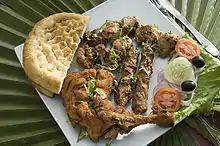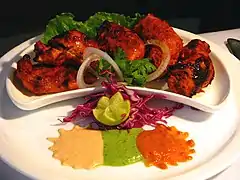Naan
Naan (Persian: نان, romanized: nān, Urdu: نان, Kurdish: نان, Pashto: ډوډی, Uyghur: نان, Hindi: नान, Bengali: নান) is a leavened, oven-baked (usually using a tandoor) or tawa-fried flatbread,[1] which is found in the cuisines mainly of Iran, Afghanistan, Central Asia, the Indian subcontinent, Indonesia, Malaysia, Myanmar, and the Caribbean.[2][3][4]
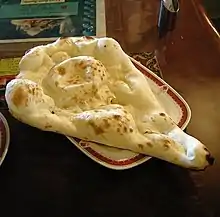 | |
| Alternative names | Nan, Noon, Paan, Faan |
|---|---|
| Region or state | Iran, South Asia, Indonesia, Malaysia, Pakistan, and the Caribbean |
| Main ingredients | Flour, yeast, salt, water |
Etymology
.jpg.webp)
The earliest appearance of "naan" in English is from 1803 in a travelogue of William Tooke.[5] The Persian word nān 'bread' is attested in Middle Persian as n'n 'bread, food', which is of Iranian origin, and is a cognate with Parthian ngn, Kurdish nan, Balochi nagan, Sogdian nγn-, and Pashto nəγan 'bread'.[6] Naan may have derived from bread baked on hot pebbles in ancient Persia.[7]
The form naan has a widespread distribution, having been borrowed in a range of languages spoken in the Indian subcontinent and also Central Asia where it usually refers to a kind of flatbread (tandyr nan).[7] The spelling naan has been recorded as being first attested in 1979,[8] but dates back at least to 1975,[9] and has since become the normal English spelling. Many English speakers refer to it as "naan bread" which is a common mistake, as simply "naan" already means "bread".[10]
Varieties
West Asia
Naan as known today originates from Mesopotamia, ancient Egypt.[7] The most familiar and readily available varieties of naan in Western countries are those from South Asia. In Iran, as well as in other West Asian nations or ethnic groups in the region, from which the word originated,[11] nân (Persian: نان) does not carry any special significance, as it is the generic word for any kind of bread.
 Nan in Iran
Nan in Iran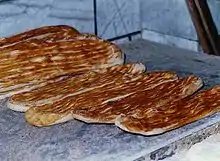 Nân-e barbari in Iran
Nân-e barbari in Iran Nân-e sangak in Iran
Nân-e sangak in Iran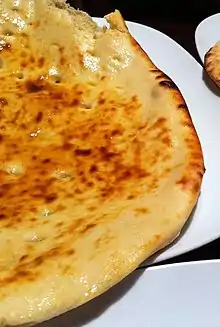 Nân-e tâftun in Iran
Nân-e tâftun in Iran
Indian subcontinent
Naan spread to Indian subcontinent during Islamic Delhi Sultanate period, earliest mention of naan in the region comes from the memoirs of Indo-Persian Sufi poet Amir Khusrau living in India during 1300s AD. Amir Khusrau mentions two kinds of naan eaten by Muslim nobles; Naan-e-Tunuk and Naan-e-Tanuri. Naan-e-Tunuk was a light or thin bread, while Naan-e-Tanuri was the heavy bread and was baked in the tandoor.[12] The Ain-i-Akbari, a written record of the third Mughal emperor’s reign also mentions naan and it was eaten with kebabs or kheema (spiced minced meat) in it. By 1700s naan had reached the masses in Mughal cultural centers in South Asia.[13]
Indonesia
In Indonesia, naan is popular in Indian Indonesian and Arab Indonesian community as well as Malay, Acehnese and Minangkabau–with other variant of roti like roti canai. This dish usually locally known as roti naan or roti nan and cooked using Indonesian spices, such as garlic with local taste.[14]
Myanmar
Naan bya (Burmese: နံပြား) in Myanmar is traditionally served at teahouses with tea or coffee as a breakfast item.[15] It is round, soft, and blistered, often buttered, or with creamy pè byouk (boiled chickpeas) cooked with onions spread on top, or dipped with Burmese curry.[15]
| External image | |
|---|---|
China
The Jingzhou style of guokui, a flatbread prepared inside a cylindrical charcoal oven much like a tandoor, has been described as "Chinese naan".[16] It is also an integral part of Uyghur cuisine, and is known in Chinese as 馕 (náng).[17][18]
Japan
After being promoted by Kandagawa Sekizai Shoukou in 1968, which is now the sole domestic manufacturer of tandoors, naan is now widely available in Indian-style curry restaurants in Japan, where naan is typically free-flow. Some restaurants bake ingredients such as cheese, garlic, onions, and potatoes into the naan, or cover it with toppings like a pizza.[19][20][21]
Elsewhere
Naan pizza is a type of pizza where naan is used as the crust instead of the traditional pizza dough. Chefs such as Nigella Lawson,[22] and supermarkets such as Wegmans[23] offer recipes for people to make their own naan pizza at home, though it is certainly not traditional.
Gallery
 Nan in Afghanistan
Nan in Afghanistan Nan in Kabul, Afghanistan
Nan in Kabul, Afghanistan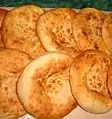 Nan in Mazar-e Sharif, Afghanistan
Nan in Mazar-e Sharif, Afghanistan


 Butter garlic naan
Butter garlic naan Paneer naan
Paneer naan Burmese nan bya
Burmese nan bya
See also
References
- Bernard Clayton's New Complete Book of Breads By Bernard Clayton Jr., Donnie A Cameron. Simon and Schuster. 1987. ISBN 9780671602222.
- Qmin by Anil Ashokan, Greg Elms
- The Science of Cooking, Peter Barham, Springer: 2001. ISBN 978-3-540-67466-5. p. 118.
- The Bread Lover's Bread Machine Cookbook by Beth Hensperger
- Russia, or a Complete Historical Account of all the Nations which compose that Empire, London, p. 168: "The most common dishes are onoschi, or vermicelli; plav, or boiled rice; nan, pancakes, and the meats which the law permits." (referring to the eating habits of the central Turks). Other attestations in English can be found in the Oxford English Dictionary, s.v. naan.
- Manfred Mayrhofer, Etymologisches Wörterbuch des Altindoarischen, Heidelberg 1996, vol. 2, p. 6,
- Pasqualone, Antonella (2018). "Traditional flat breads spread from the Fertile Crescent: Production process and history of baking systems". Journal of Ethnic Foods. 5 (1): 10–19. doi:10.1016/j.jef.2018.02.002. ISSN 2352-6181.
- "Home : Oxford English"$ Dictionary". oed.com. Retrieved 6 September 2015.
- Milton Glaser and Jerome Snyder. "Delhi Delights", New York Magazine, August 11, 1975, p. 73
- "Definition of NAAN". www.merriam-webster.com. Retrieved 6 May 2023.
- "Naan - Definition of naan". merriam-webster.com. Merriam-Webster. Retrieved 6 September 2015.
- "History of Naan". Times of India. 11 June 2020.
- Dash, MadhulIka (2015). "Breaking Bread" (PDF). No. May–June. Forbes life india. Forbes.
- "Baking with Eda: 'Naan' Indonesian Flatbread".
- "Eating in Burma". Travelfish. Retrieved 29 May 2023.
- "This 1,000-Year-Old Chinese 'Naan' Was Once Cooked in a Hat, and It's Yummy".
- "Uighur Nan with Cumin and Onion Recipe".
- "Have You Ever Seen Uyghur Bazaar Naan? It's So Fluffy and Delicious | TRP".
- "【近ごろ都に流行るもの】「カレーにナン」本場インド以上に普及・巨大化". 27 July 2018.
- "インド人が驚く日本の「ナン」独自すぎる進化 | 食べれば世界がわかる!カレー経済圏". 6 May 2019.
- "日本のインド料理店のナンが大きい理由 | 雑学ネタ帳".
- Nigella. "NAAN PIZZA - Recipes - Nigella Lawson". nigella.com. Retrieved 6 September 2015.
- "Recipes - Wegmans". wegmans.com. Archived from the original on 1 May 2014. Retrieved 6 September 2015.
External links
 Media related to Naan at Wikimedia Commons
Media related to Naan at Wikimedia Commons Cookbook:Naan at Wikibooks
Cookbook:Naan at Wikibooks
